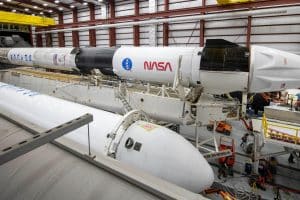Key Points
- 🚀 NASA and DARPA have awarded Lockheed Martin and BWX Technologies a contract to develop a nuclear thermal rocket (NTR) engine.
- 💰 NASA and DARPA will commit up to $499 million towards the program.
- 🚀 The engine will be built under DARPA’s DRACO program and can fit in the fairing of a SpaceX Falcon 9 or United Launch Alliance Vulcan Centaur.
- 🚀 An NTR achieves high thrust and is two to three times more efficient than in-space chemical propulsion.
- 🛠️ The engine will be powered by a fission nuclear reactor engine designed by BWX Technologies and fueled by High Assay Low Enriched Uranium (HALEU).
- 🚀 The NTR provides propulsion by transferring reactor heat to liquid hydrogen, producing thrust through expansion.
- 🚀 The launch target for the engine is late 2025 or early 2026.
NASA and DARPA Award Lockheed Martin and BWX Technologies Contract for Nuclear Thermal Rocket (NTR) Engine
NASA and DARPA recently announced that they have selected Lockheed Martin and BWX Technologies to collaborate on the development of a nuclear thermal rocket (NTR) engine. This joint effort falls under DARPA’s DRACO (Demonstration Rocket for Agile Cislunar Operations) program, in partnership with NASA, with a total investment of up to $499 million.
During a press conference, Dr. Tabitha Dodson of DARPA revealed that the test bed’s exact size was not disclosed, but it would be compact enough to fit inside the fairing of a SpaceX Falcon 9 or United Launch Alliance Vulcan Centaur, negating the need for a heavy lift vehicle.
An NTR is capable of producing high thrust similar to in-space chemical propulsion, but it offers significantly higher efficiency, being two to three times more efficient. The successful demonstration of the nuclear thermal rocket technology could revolutionize space exploration by enabling faster and farther journeys and opening the way for future applications of fission-based nuclear space technologies.

The engine will be powered by a fission nuclear reactor engine designed by BWX Technologies and fueled by High Assay Low Enriched Uranium (HALEU). This type of system is much different than RTG systems used on Mars rovers, for example. RTG systems provide no thrust and only convert heat to turn into power.
The NTR provides propulsion by directly transferring reactor heat to liquid hydrogen, then the heated gaseous hydrogen expands through the nozzle to provide thrust. The liquid hydrogen will go from -20° Kelvin (-253° Celsius) to 2,700° Kelvin (2,426° Celsius) in less than a second as it expanded out through the nozzle.
For the liquid hydrogen side of the engine, there will be about 2,000 kg loaded, and will also provide a test to see how long they will be able to maintain the correct temperatures for the liquid hydrogen.
The reactor for the engine will not be turned on until after it has reached a “nuclear safe orbit,” which is more than 700 km above Earth. International standards are that the rocket would need to stay in a circular orbit for around 300 years. There has been no specific orbit decided yet.
The United States Space Force will select the launch vehicle, most likely to be a Falcon 9 or Vulcan Centaur, but it is a bit too early for that announcement. The teams are also looking at the ability to refuel the test bed, as once the liquid hydrogen runs out, the mission would be over.
NASA and DARPA are looking at a launch target of late 2025 or early 2026.
What do you think of this technology?





